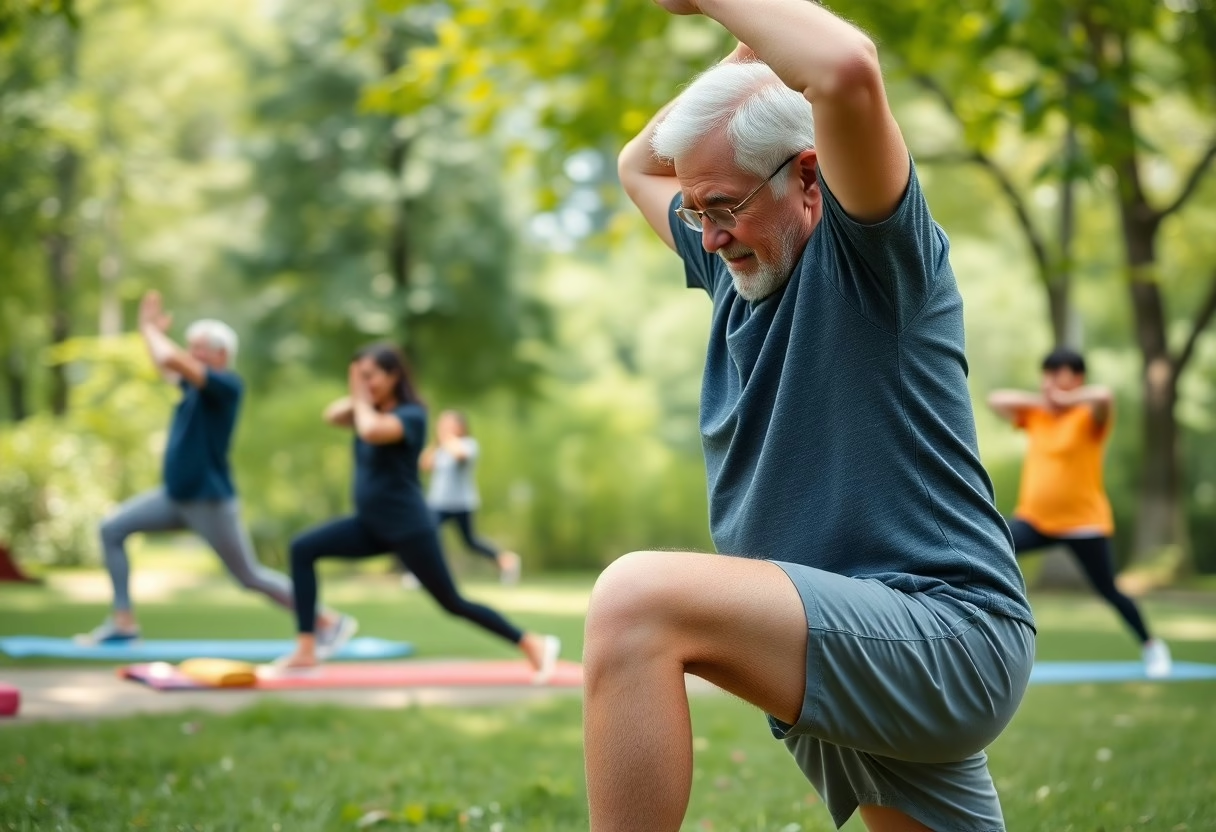There’s no denying that our joints play a vital role in how we move and enjoy life. As I explore into the fundamentals of joint health, I will share effective strategies and insights to help you maintain and protect your mobility over time. From understanding the anatomy of your joints to exploring exercises and dietary choices that support joint well-being, this guide aims to empower you with knowledge for a healthier, more active lifestyle. Let’s take a closer look at how you can ensure your joints remain strong and functional throughout your life.
Key Takeaways:
- Maintaining a healthy weight and engaging in regular exercise can significantly enhance joint health and mobility.
- Incorporating a balanced diet rich in omega-3 fatty acids, antioxidants, and vitamins can help support joint function and reduce inflammation.
- Staying hydrated and practicing proper body mechanics can prevent joint stress and injuries, contributing to long-term mobility preservation.
Understanding Joint Health
Your joints play a vital role in your overall mobility and quality of life. They are vital for daily activities, allowing movement and flexibility. Understanding how your joints function and what factors can influence their health is key to maintaining your ability to move freely throughout your life.
Anatomy of the Joints
Across the human body, joints are sophisticated structures where two or more bones meet. They are composed of various components, including cartilage, synovial fluid, ligaments, and tendons, which work together to provide stability and ease of movement while allowing a range of motions.
Common Joint Issues
Joint pain and dysfunction can arise due to various factors ranging from injury to chronic conditions. Symptoms may include stiffness, swelling, and reduced range of motion, which can significantly affect your daily activities and overall quality of life.
Hence, it’s important to be aware of common joint issues, such as arthritis, tendinitis, and bursitis, as they can develop gradually or suddenly. Lifestyle choices, age-related wear and tear, or previous injuries can lead to these conditions, limiting your mobility and causing discomfort. Early identification and management of these issues are integral to preserving joint health and ensuring a more active lifestyle.
Importance of Joint Mobility
You may not realize how vital joint mobility is until it starts to decline. Good joint mobility allows for flexibility, strength, and movement, which are vital for performing daily activities. Maintaining this mobility can enhance your quality of life as it supports your overall physical health and independence. By investing in joint health, I believe I am laying a foundation for a more active lifestyle, enabling me to engage in activities I love for years to come.
Impact on Daily Life
After experiencing reduced joint mobility, you may discover that even simple tasks become challenging. Everyday activities like climbing stairs, bending down, or lifting objects can become painful or exhausting. This restriction not only impacts your physical capabilities but can also affect your social interactions and emotional well-being. I find that maintaining my joint mobility helps me enjoy life more fully and participate in various activities without fear of discomfort.
Long-term Benefits
With consistent attention to joint health, you can unlock numerous long-term benefits that extend far beyond daily comfort. Improved mobility can lead to a greater ability to pursue hobbies, maintain an active lifestyle, and reduce the risk of injury and chronic conditions associated with immobility.
At the core of long-term benefits lies a significant decrease in health complications. When I prioritize my joint mobility, I’m not just addressing present discomfort; I’m also minimizing the risk of arthritis and other degenerative conditions. By fostering strength and flexibility in my joints, I create a healthier, more resilient body that can withstand the wear and tear of everyday life. This proactive approach ultimately leads to enhanced physical wellness and a better quality of life as I age.
Factors Affecting Joint Health
Despite the common perception that joint issues are solely the result of aging, various factors can significantly influence your joint health throughout your life. These factors include:
- Genetics
- Body weight
- Activity level
- Nutrition
- Injury history
Assume that understanding these factors will empower you to make more informed choices that benefit your mobility and overall quality of life.
Age and Genetics
Around the world, you will notice that some people develop joint issues earlier than others, often due to genetic predispositions. If your family has a history of conditions like osteoarthritis or rheumatoid arthritis, you may find that you have a higher risk of similar joint problems as you age.
Lifestyle Choices
Beside genetic factors, your lifestyle choices play a significant role in your joint health. Regular physical activity, a balanced diet, and weight management are all aspects one needs to consider for maintaining healthy joints.
Even small changes in your daily habits can have a lasting impact on your joint health. Engaging in low-impact exercises such as swimming or cycling can strengthen the muscles around your joints, while maintaining a nutritious diet rich in anti-inflammatory foods will aid in reducing joint pain and stiffness. Prioritizing your holistic well-being also means avoiding excess weight, which can place additional stress on your joints. Make informed choices today to support your mobility for years to come.
Preventative Strategies
Many individuals overlook the significance of preventative strategies for maintaining joint health. By adopting a proactive approach, you can significantly reduce your risk of joint-related issues. Incorporating a balanced lifestyle, focusing on nutrition, and committing to regular exercise can empower you to protect your mobility for life.
Nutrition for Joint Health
The foods you consume play a vital role in supporting your joint health. Incorporating anti-inflammatory foods, such as fatty fish rich in omega-3 fatty acids, colorful fruits, and vegetables can aid in reducing inflammation and improving joint function. I encourage you to include nuts, whole grains, and low-fat dairy in your diet to promote stronger joints and overall well-being.
Exercise and Physical Therapy
Strategies for maintaining your joint health include regular exercise and engaging in physical therapy when needed. Incorporating low-impact activities like swimming or cycling can enhance your joint flexibility and strength without causing excessive strain.
Also, consulting with a physical therapist can provide personalized exercises tailored to your specific needs, helping you to improve your range of motion and reduce pain. Strength training can build the muscles surrounding your joints, offering necessary support and stability. This holistic approach not only improves your joint health but also enhances your overall mobility and quality of life.

Natural Remedies and Treatments
To enhance joint health, I focus on natural remedies and treatments that promote mobility and reduce discomfort. Incorporating practices such as exercise, healthy nutrition, and mindfulness can provide significant benefits. Additionally, I find that herbal remedies and necessary oils offer alternative options for managing pain and inflammation. By exploring these natural approaches, you can better support your joint health and maintain an active lifestyle.
Supplements for Joint Support
At times, I turn to supplements specifically formulated to support joint health. Ingredients like glucosamine, chondroitin, and omega-3 fatty acids have shown potential in providing relief from joint discomfort and promoting overall joint function. By integrating these supplements into my routine, I aim to improve my mobility and maintain an active lifestyle.
Alternative Therapies
Alternative therapies can also be beneficial for joint health. I have explored various options, such as acupuncture, which targets specific points to alleviate pain and improve function. Additionally, I find that practices like yoga and tai chi not only strengthen my joints but also enhance flexibility and balance. These holistic approaches allow me to connect my mind and body, fostering a sense of well-being.
Remedies such as massage therapy, herbal treatments, and aromatherapy can further enhance your joint care routine. These modalities can provide relief by increasing circulation, reducing tension, and creating a soothing environment. By combining these alternative therapies with a holistic lifestyle, I believe you can promote better joint health and ultimately improve your overall quality of life.
Monitoring and Professional Care
Now, maintaining joint health isn’t just about proactive measures; it’s important to monitor changes in your mobility and seek professional care when necessary. Regular check-ups with healthcare providers can help identify issues early, allowing you to address them before they escalate. Whether it’s through physical examinations or imaging studies, staying informed about the state of your joints will empower you to take action and preserve your mobility over time.
When to Seek Help
When you notice persistent discomfort, swelling, or stiffness in your joints, it’s time to consult a healthcare professional. Delaying intervention can lead to further complications, making it important to address your concerns as soon as possible. A timely evaluation can lead to appropriate treatment options tailored to your specific condition, helping to restore your joint function and improve your quality of life.
Managing Chronic Conditions
Seek to develop a comprehensive plan with your healthcare provider if you have a chronic condition affecting your joints, such as arthritis or diabetes. This can include medication management, physical therapy, or lifestyle changes tailored to meet your individual needs.
Even a well-managed chronic condition can impact your joint health over time, so it’s important to stay proactive. Regularly updating your treatment plan can help mitigate symptoms while enhancing your mobility. Collaborating closely with your healthcare team allows you to tailor interventions, monitor progress, and make necessary adjustments to maintain optimal joint health. By staying engaged with your health, you can navigate the challenges of chronic conditions effectively and protect your joints for the long haul.
Final Words
With this in mind, I believe understanding joint health fundamentals is necessary for protecting your mobility throughout life. By prioritizing your joint care through proper exercise, nutrition, and awareness of your body’s signals, you can enhance your quality of life. For further insights and resources, you might find the Health Lesson: Learning About Joints | NIAMS helpful in guiding your journey to maintain healthy joints.



